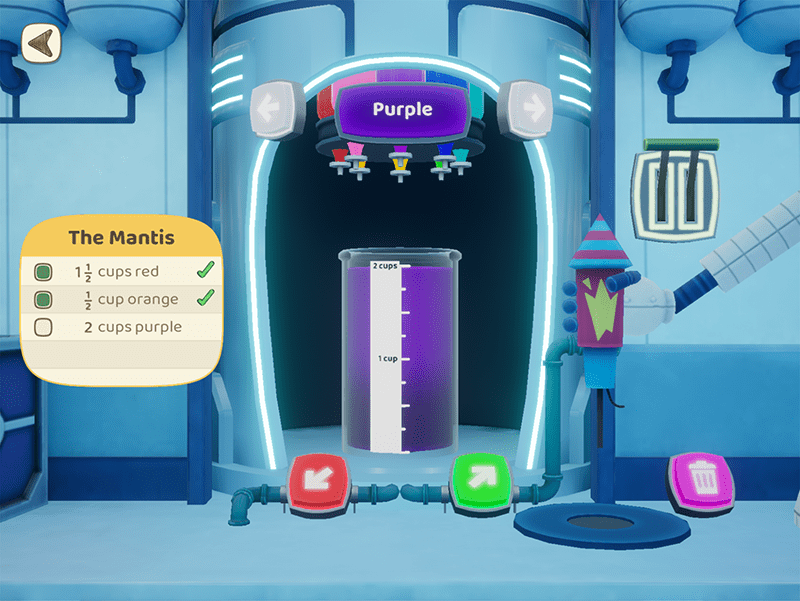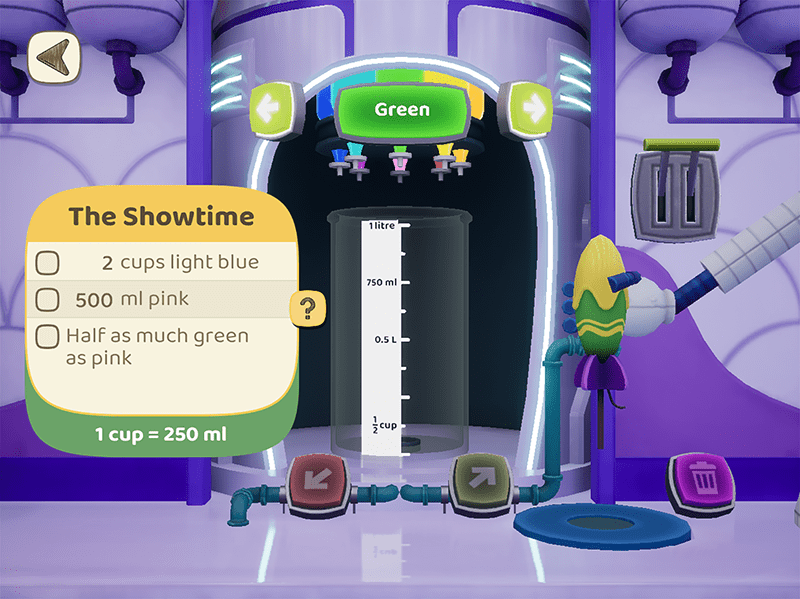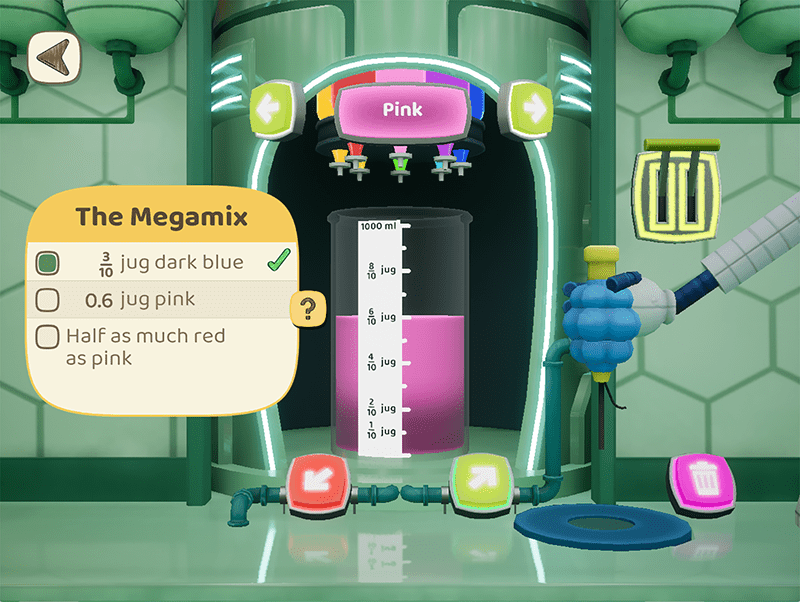Back to library
Maths in Town Squared: fractions and measurement in the Factory
About these maths activities
In these activities, children measure out liquid ingredients to make items that they can use in other parts of the game: fireworks, jelly rockets or suds bombs. The task mimics the real-world experience of using a measuring jug at home to create a great effect in the imaginary world of the town.

The fireworks activity with a puzzle (recipe) in progress. The first two colours in the recipe have been added, and the recipe panel shows that these were measured accurately. The purple colour has been poured into the jug and is ready to be added to the rocket on the right.
When they enter an activity, children are invited to make products to help the town, and in return they will get to keep one of the products for themselves.
Children start with a recipe that shows the names and amounts of the ingredients required. Next to the recipe is a workstation where children can find the right ingredient and pour it into a jug marked with lines and measurements.
When the child thinks they have accurately measured an ingredient, they pour it into a nearby container. As ingredients are added the recipe card updates, giving feedback about whether the amount measured and colour chosen are accurate. Children can choose to discard their mix and try again at any point or they can keep working on the problem.
When they feel the product is ready, it can be tested by tapping a switch that sends it to the test area. The product is set off near a test dummy:
- If the ingredients have been measured accurately, it delights the test dummy, and the firework, jelly rocket, or suds bomb is either donated to the town or given to the child.
- If ingredients are missing or inaccurately measured, the product will misfire, and the dummy is on the receiving end of the disaster! Children are then given feedback about the way they approached measuring, and are encouraged to try again. This playful approach to an unsuccessful attempt helps reframe the outcome away from a ‘pass’ or ‘fail’, instead making it part of the ongoing problem solving and experimentation process.

A successfully completed Fireworks recipe results in a firework that delights the test dummy.
There are three activities in the Factory, each with a different level of challenge.
Fireworks
This activity measures in whole numbers, simple fractions, percentages and equivalent units. Usually there is a label on the jug that matches the recipe.
The fireworks made in the activity can be used on quests - let one off and it distracts sprites while you clean them.

A Factory Fireworks activity is part way through. Half a cup of pink - the first item on the recipe - is being poured into the container.
Jelly rockets
This activity follows on from the fireworks activity, with more complex recipes. It includes translating between fractions, percentages, and millilitres and introduces the concept of conversion using a conversion table. Some recipe items are simple word problems, such as ‘twice as much green as purple’.
The jelly rockets made in the activity can be used in quests to slow sprites down - giving you a chance to clean them.

A Factory Jelly rockets activity is beginning. There are three items on the recipe, one of which is a word problem. There is a conversion chart under the recipe.
Suds bombs
This activity follows on from the jelly rockets activity, with conversions, word problems, and more complex translating between the recipe and the measuring jug. It also introduces estimation, with measurements that fall between the lines on the jug.
The suds bombs made in the activity can be used on quests to instantly clean any sprite they hit. A useful asset when they’re coming after you!

A Factory Suds bombs activity is part way through. 0.6 litres of pink - the second item on the recipe - has just been measured into the container. This recipe also contains a word problem.
How does this puzzle relate to the Cambridge Big Ideas in Mathematics?
Cambridge University developed the Cambridge Big Ideas in Mathematics, based on concepts proposed by Randall I. Charles1. The Big Ideas described below help represent and teach maths as a connected and coherent area of learning, and they underpin the design of puzzles in Town Squared.
Big Idea 3: Equivalence
‘Any number, measure, numerical expression, algebraic expression, or equation can be represented in an infinite number of ways that have the same value.’
In the Factory children can:
- match whole numbers, fractions, decimals and percentages in recipes with their equivalents on the measuring jugs, in increasingly challenging ways
- read recipes and complete tasks to explore how different units can be used to measure the same amount of liquid
- use the game feedback mechanisms to test ideas of equivalence and try different strategies to achieve a result.
Big Idea 4: Comparison
‘Numbers, expressions, and measures can be compared by their relative values.’
In the Factory children can:
- compare whole numbers, fractions, decimals and percentages in recipes and on measuring jugs, to create a result in increasingly challenging ways
- read recipes and complete tasks to explore how different units can be used to measure the same amount of liquid
- use the game feedback mechanisms to compare different measures and try different strategies to achieve a result.
Big Idea 7: Basic facts and algorithms
‘Basic facts and algorithms for operations with rational numbers use notions of equivalence to transform calculations into simpler ones.’
In the Factory children can:
- simplify fractions and translate between different units shown as whole numbers, fractions (proper, improper, mixed), decimals and percentages to create a result in increasingly challenging ways
- read the conversion table provided, then try different strategies to convert some amounts, and see feedback on their choices
- read word problems, then try different strategies to scale a given ingredient by the amount described, and see feedback on their choices.
Big Idea 8: Estimation
‘Numerical calculations can be approximated by replacing numbers with other numbers that are close and easy to compute with, mentally. Measurements can be approximated using known referents as the unit in the measurement process.’
In the Factory children can:
- use the game feedback mechanisms to test ideas about estimation and try different strategies
- use lightly-marked or unmarked measuring jugs to estimate the amounts required by a recipe (applies to the highest levels of the puzzle only).
How do the activities scale in complexity?
Each activity (fireworks, jelly rockets or suds bombs) comprises a range of puzzles (individual recipes) that address different measuring and estimating tasks. Overall, the series of three activities are intended to follow on and extend from each other in terms of complexity and the amount of scaffolding provided to help children complete the puzzles:
-
Fireworks activity: foundation puzzles with scaffolding, including strategies to work out the answers
-
Jelly rockets activity: increasingly complex puzzles and scaffolding is reduced, for example fewer text labels and strategy suggestions
-
Suds bombs activity: the most complex puzzles with multiple mental arithmetic steps, and scaffolding is reduced to hints.
All three activities can be accessed at any time so children can explore and experiment, and so teachers can direct them to a particular area of maths.
If a child makes an unsuccessful attempt at a puzzle, they receive feedback and are encouraged to try again. Multiple unsuccessful attempts automatically move them to puzzles with a lower level of complexity. This aims to ensure that children aren’t too discouraged, and to help teachers identify the challenge point for that child.
When children successfully complete the highest level of the activity, puzzles are chosen at random from the upper levels.
Fireworks activity
The fireworks activity covers measuring in fractions, percentages and equivalent units. Initial puzzles (recipes) in the fireworks activity establish the low-floor task: read whole numbers and simple fractions on the recipe, find the matching label on the jug, and pour in liquid up to that marker line.
Puzzles are grouped by difficulty level and scale up from this ‘low floor’ as follows:
-
Lower levels – puzzles start with whole numbers and simple fractions. The jug uses the same units as the recipe, all amounts are marked on the jug and most amounts on the jug display a matching label.
-
Mid levels – every recipe amount has a marker line on the jug but some are not labelled, so children need to read the other labels to work out where to measure.
-
Higher levels – puzzles introduce units other than fractions of a cup; some jug labels use a different but equivalent unit to the one shown in the recipe (for example, 50% of a cup instead of half a cup), requiring the child to translate across units to measure accurately.
Each level introduces new measures, while reusing some of the quantities shown in previous levels.
|
Difficulty level |
This group of puzzles addresses these concepts |
|
Level 1 |
Measure fractions of a cup: one quarter, one half, three quarters, plus some whole numbers (1 cup). |
|
Level 2 |
Measure mixed fractions in a 2 cup measuring jug, using a whole number plus one quarter, half or three quarters. |
|
Level 3 |
Measure a range of fractions of a cup, including thirds and sixths. |
|
Level 4 |
Measure a range of fractions and percentages of a cup. |
|
Level 5 |
Measure fractions and decimals of a cup, and begin measuring in millilitres (whole numbers, three digits). |
|
Level 6 |
Using a litre container, measure a mix of fractions, percentages and millilitres (whole numbers, three digits). Recap and generalise across all previous puzzles. |
Total number of puzzles: 37
Jelly Rockets activity
This activity follows on from the fireworks activity, beginning with a recap of measurement using the units explored in the fireworks activity, then introducing the concept of conversion using a conversion table.
Puzzles are grouped by difficulty level, scaling up with each new puzzle so that each level builds on the previous one.
|
Difficulty level |
This group of puzzles addresses these concepts |
|
Level 1 |
Read and convert between fractions, decimals, percentages, and millilitres (whole numbers). Introduces a conversion table to convert one or two amounts in a given recipe. Read simple word problems to scale one or two ingredients (for example, half as much, twice as much). |
|
Level 2 |
Use the conversion table provided to convert between fractions, decimals, percentages and millilitres. Read word problems to scale some ingredients (for example, this much more than, this much less than). |
|
Level 3 |
Use the conversion table provided to convert between fractions, decimals, percentages and millilitres (whole numbers). Uses a larger container and larger numbers. Read a range of word problems to scale some ingredients. |
|
Level 4 |
Read and convert between proper and improper fractions, and use more measuring jugs with unlabelled marker lines. |
|
Level 5 |
Use the conversion table provided to convert between fractions and millilitres (whole numbers). Recipes are constructed to make the connection that an eighth is half as big as a quarter. |
|
Level 6 |
Measure with thirds and sixths, including improper fractions, using measuring jugs with more unlabelled marker lines. Recap and generalise across all previous puzzles. |
Total number of puzzles: 37
Suds Bombs activity
This activity follows on from the jelly rockets activity, beginning with a recap of translation between the equivalent units used in the jelly rockets activity and introduces estimation. This activity expands on units used in other activities, including measuring in tenths and twelfths in higher levels, and includes more complex word problems and conversion tasks.
During the activity, the workstation ‘malfunctions’ and labels and measuring lines disappear from the jug. This introduces estimation, starting with finding an amount that falls halfway between given marker lines. The final level requires measuring or estimation with only two marker lines and no labels, and conversion between equivalent units and/or reading a word problem to work out how to scale the ingredient.
|
Difficulty level |
This group of puzzles addresses these concepts |
|
Level 1 |
Measure with fractions (proper and improper), decimals and percentages. Simplify fractions and convert between units. Use word problems to scale amounts, and use measuring jugs with some unlabelled marker lines. |
|
Level 2 |
Measure in millilitres and convert to fractions of a cup with fewer labels on the measuring jug. Includes fractions, decimals, percentages and millilitres (whole numbers), scaling amounts and word problems. |
|
Level 3 |
Measure in twelfths of a cup. Includes conversion between fractions, decimals, percentages and millilitres (whole numbers), scaling amounts and word problems. |
|
Level 4 |
Measure in tenths of a cup with fewer & more inconsistent labels on the measuring jug. Includes translation between fractions, decimals, percentages and millilitres (whole numbers), scaling amounts and many word problems. |
|
Level 5 |
Measure fractions, decimals, percentages and millilitres with very limited labelling on the measuring jug. Convert between units using the conversion table provided. Introduces estimation, where some amounts are halfway between the marks on the measuring jug. |
|
Level 6 |
Use a measuring jug with 2 marker lines (half way and full), and one label, to measure or estimate amounts in fractions, decimals, percentages and millilitres. Convert between units using the conversion table provided. Includes scaling amounts and word problems. |
Total number of puzzles: 37
How do these activities improve disposition towards maths and learning?
Children sometimes wonder why they are asked to do a particular maths task.The Factory activities are designed to be a direct parallel to a familiar and relevant real-world application of the maths, showing how measuring, translating between units, converting and estimating are useful for following recipes (for example, for cooking or science experiments). These activities are also highly relevant and rewarding in the imaginary world of the game as children get a useful product that helps them complete quests and earn blocks (in-game currency).
The activities allow children to formulate and test different strategies to solve a puzzle, use feedback to think through a strategy, and ‘learn by doing’:
-
Children can pour any amount of liquid into the jug, and discard it if they think they’ve measured inaccurately. This allows them to experiment with the idea of the amount and unit shown. This matches the way we measure ‘in real life’, adding and removing an ingredient until it reaches the line on a jug.
-
When the child thinks they’ve measured accurately they add that ingredient to the container. The recipe card then updates to give the child feedback about whether the ingredient chosen is correct (reading and comprehension skill) and amount measured accurate (mathematical skill).
At this point the child can choose what to do with the feedback and may:
-
correct any mistakes in ingredients or measurement by emptying the container and trying again.
-
ignore this feedback and proceed to test the product.
-
Children can send a container to be tested, even if they know some of their measuring was inaccurate – they will simply get a comically ‘bad’ test result and will not be able to keep the product. The playful approach helps to reduce negative associations with ‘getting it wrong’, which can feed into maths anxiety. They will then be prompted to have another try, or (if they have multiple unsuccessful attempts) be scaled back to a level where they previously experienced success.
-
The activities and puzzles are all untimed, so children can take as long as they need to think about what each recipe is asking for and fine tune their choices. This is very useful for maths-anxious children, as it reduces the pressure on the task.
-
All the recipes include a Help button. This can be accessed at any time during play and provides visual and text suggestions for strategies the child can use to work out how to measure the amounts they need.
The activities use in-game rewards to motivate children. All the items made in the Factory are useful in quests because they slow down the sprites, which means children can clean the sprites more easily and earn the game currency faster. They also have amusing effects if set off in the town. This motivates children to go back to the Factory and keep trying to solve the measuring puzzles so they make more of the items to take on their next quest.
References
Charles, Randall I., (2005). Big ideas and understandings as the foundation for elementary and middle school mathematics. Journal of Education Leadership, 7(3), 9-24. Available from: https://www.jaymctighe. com/wp-content/uploads/2011/04/MATH-Big-Ideas_ NCSM_Spr05v73p9-24.pdf
